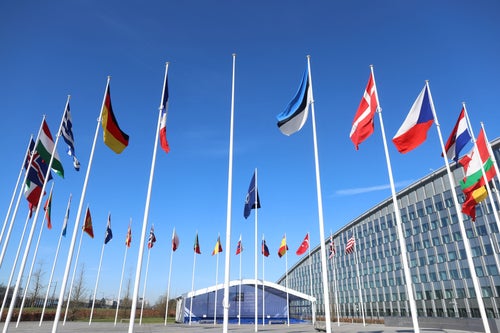

Finland will today become the 31st member of NATO in a move which further bolsters the military alliance.
It comes less than a year after the previously-neutral country first submitted its application in the wake of Russia’s invasion of Ukraine.
Here, HuffPost UK explains the background to what it is happening and why it is so significant.
What is NATO?
The military alliance goes by the acronym of Nato.
The North Atlantic Treaty Organisation was formed in 1949 to prevent a resurgence of nationalism and militarism in Europe after two world wars, and to deter the Soviet Union’s expansion.
Its membership has swelled to 30 member nations, and over the 1990s and 2000s its enlargement stretched further east to include the former Soviet republics of Estonia, Latvia and Lithuania.
They agree to mutual defence — military action — in response to an enemy attack. The principle goes: “An attack against one ally is considered as an attack against all allies.” This is Article 5 of the Nato constitution.
Nato’s enlargement has been Vladimir Putin’s biggest publicly-stated grievance with the West, with the Russian president claiming the eastward expansion breaks assurances given when the Soviet Union ended.
Adding Finland - and probably Sweden - is likely to trigger Putin’s ire too, but Nato general secretary Jens Stoltenberg has said it is up to individual nations whether they wish to apply for membership.
He said Finland becoming a member “will be a good day for Finland’s security, for Nordic security, and for Nato as a whole.”
Why is Finland’s decision significant?
Finland, which shares a 1,300-km (810-mile) border with Russia, gained independence from Moscow in 1917 and fought two wars against it during World War II, where it lost some territory.
Finland signed an Agreement of Friendship, Cooperation, and Mutual Assistance with Russia in 1948, cementing a degree of economic and political dependency and isolating it militarily from western Europe.
The strict policy of neutrality was known as “Finlandization.”
The end of the Cold War 30 years ago allowed the country to step out of Russia’s shadow as the threat from Moscow diminished.
Following the agreement of Turkey, Finland’s Nato membership will be made official this afternoon.
It marks a decisive break from the past and places Finland firmly on the side of western opposition Russia’s actions in Ukraine.
Will Sweden be next to join?
Like Finland, Sweden’s policy of strict neutrality ended with Russia’s invasion, and they also applied to become Nato members.
Although it is still likely to happen, the process has been slowed down by Turkey, which has so far refused to ratify the move. Under Nato’s rules, new countries can only join with the unanimous support of existing members.
The Turkish government has said Sweden has not taken strong enough steps to eradicate pro-Kurdish groups which it sees as terrorists, and will not give the green light to the country’s Nato membership until it has done so.
How will Russia react to Finland’s NATO membership?
Badly.
Speaking last June, Vladimir Putin insisted he was relaxed about the prospect of Finland (and Sweden) joining the alliance.
He said: “If Finland and Sweden want to, they can join. That’s up to them. They can join whatever they want.”
But the Russian president added: “If military contingents and military infrastructure were deployed there, we would be obliged to respond symmetrically and raise the same threats for those territories where threats have arisen for us.”
Regardless of the Russian response, it is already clear that Putin’s hope that his invasion of Ukraine would splinter western unity has spectacularly backfired.